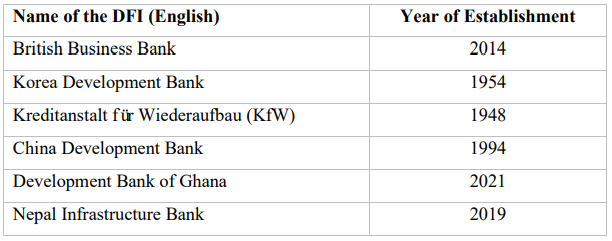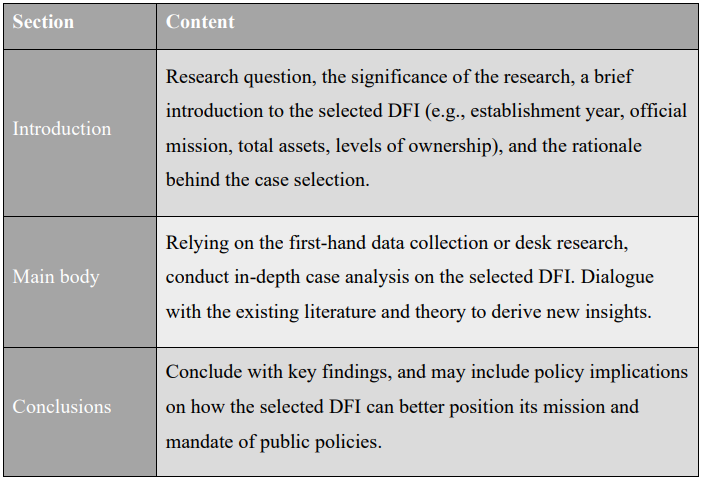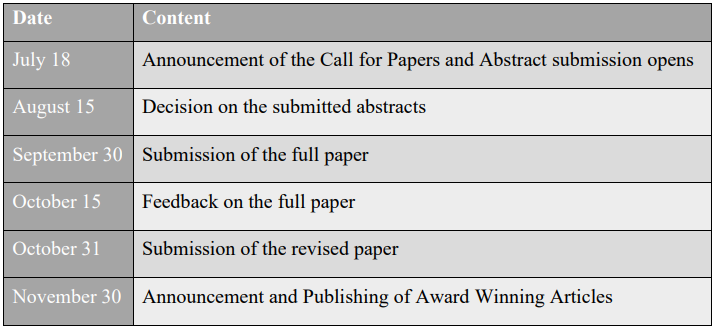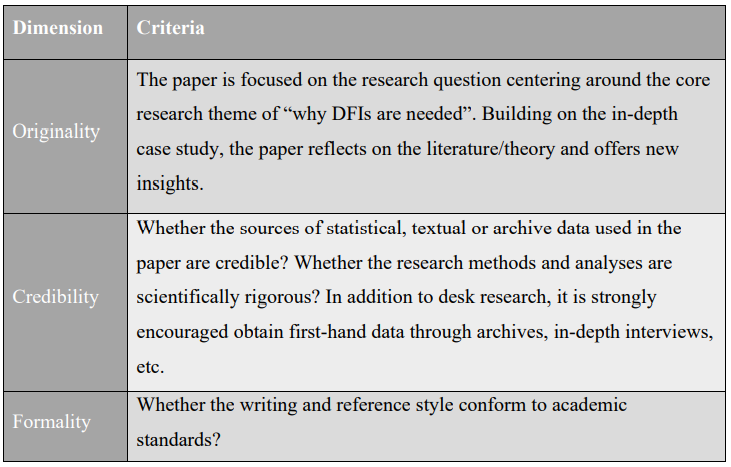
1. Research Background
The world is witnessing a renaissance of development financing institutions (DFIs). Both developed and developing countries have established or are in the process of establishing DFIs to achieve socio-economic development goals as well as address global development challenges such as climate change. Although DFIs (such as the World Bank, Asian Infrastructure Investment Bank, China Development Bank, etc.) have played a pivotal role in providing medium- and long-term financing as well as achieving economic structural transformation in a sustainable and inclusive manner, there is little research on DFIs in the mainstream literature. The mainstream view often tends to argue that DFIs are prone to government failure and thus should be dismantled or privatized. Nonetheless, the afore-mentioned mainstream view cannot explain the following puzzles: DFIs have not become extinct; instead, DFIs are prevalent around the world (including developed countries). In fact, the world is witnessing a renaissance of DFIs. According to the world’s first development financing institutions database initiated by the Development Financing Research Program of the Institute of New Structural Economics (INSE) at Peking University and then collaborated with the French Development Agency, there are more than 520 DFIs from over 160 economies, with aggregate total assets of 22 trillion US Dollars.
New Structural Economics (NSE) provides a useful analytical framework for developing original development financing theories. NSE is a theoretical framework for studying economic development, transition and operation proposed and championed by Prof. Justin Yifu Lin – the former Chief Economist of the World Bank and the first intellectual from developing countries that holds this position – and his collaborators. NSE aims to incorporate the endogeneity and heterogeneity of structural differences between developed and developing countries into the analysis of modern economics. Centering around the core question of how finance can better serve the real economy, NSE has developed the theory of “the most appropriate financial structure”, emphasizing that different financial arrangements have distinct comparative advantages in serving different financing needs of the real economy.
Based on this original analytical framework, the INSE and the Institute of South-South Cooperation and Development (ISSCAD) at Peking University jointly launched the Development Financing Research Program, aiming to lead the database construction, academic research and policy dialogue of development financing. The Development Financing Research Program at INSE has built the world’s first database of development financing institutions, which is the most comprehensive database of public development banks and development financing institutions to date and has laid the foundations for both original academic research and policy research on development financing.
2. Goals
The Development Financing Research Program at INSE is now launching the Case Study Series on DFIs, calling for contributions from researchers and outstanding students around the world. Each series will focus on a specific research theme, and select representative DFIs at the choice of the applicant for in-depth case study. The goal is to provide a thoughtful analysis on the selected DFI in depth and complete a high-quality qualitative case study.
The launch of the Case Study Series on DFIs aims to enrich the original academic research with real-life examples to deepen the understanding of DFIs among scholars, practitioners and policy makers, with the goal of maximizing the potentials of DFIs in promoting economic structural transformation and sustainable development.
3. Case Selections
3.1. Suggestions on the cases
It is advised to select the DFI of your interest from the aforementioned world’s first database on development financing institutions. To name a few examples listed in the database:

The complete list of the DFIs can be accessed at: http://www.dfidatabase.pku.edu.cn/datadownloading/index.htm
NOTE:If the DFI of your interest is not included in the above-mentioned list, please contact the organizers before submitting your abstract to make sure whether the institution of your choice qualifies as a DFI and whether it can be used for your case analysis.
3.2. Selection criteria
In principle, any of the DFIs included in the aforementioned database can be used for case study. However, considering the availability and credibility of information and data, it is highly recommended that the chosen institution should meet the following conditions:
• it has an official website;
• it has publicly disclosed official documents, including but not limited to the founding document of the institution (i.e., articles of agreement), annual reports, financial statements, activity reports, sustainability reports, etc.;
• if the chosen institution also discloses project-level information or data, it is advised to also include this into your analysis.
4. Research Topics
Centering around the overarching research theme of “Why DFI are needed”, there are six specific research questions:
(1) What are the official mandate and public policy areas served by the chosen DFI? Are market failures present in the areas served by the DFI? If so, what is the nature of market failure? Put differently, why are commercial banks or capital markets unable to provide (sufficient) financing in those areas served by the chosen DFI?
(2) Compared with alternative means of governmental intervention in the financial system, what are the comparative advantages of DFIs established by the governments in addressing those market failures?
(3) Why do governments in high-income economies with fully-fledged developed capital markets and well-established commercial banking systems still choose to establish DFIs?
(4) How does the mandate and mission of DFIs keep pace with structural transformation as the economy develops from low-income to high-income status?
(5) Comparing economies at different stages of development, what are the similarities and differences with respect to the nature of market failures, and what are the differences in the official mandate of DFIs as well as the underlying rationales for establishing them?
(6) Some DFIs are established with the mission to help developing countries instead of supporting domestic development of their home countries (e.g., French Development Agency). What are the underlying rationale and driving forces behind their establishment? How do these DFIs balance their nonmarket strategies and overall investment risks? This is especially relevant for DFIs that have shifted their focus to helping fragile and conflict-affected states.
As a reference point, the structure of the full paper can (but does not have to) take the following layout:

5. Target of This Call for Papers
The Case Study Series on DFIs call for applications from researchers (such as professors from universities or researchers from research institutes) or students in the following areas: international development, development studies, economics, finance, accounting, business. Nonetheless, there is no strict requirement on the research profile or study background of the applicants.
6. Timeline
The Case Study Series on DFIs kickstarted in early July 2022 and will end on November 30th, 2022. Important dates to keep in mind are listed below:

7. Award Evaluation Criteria
Selected articles will be evaluated against the following criteria:

8. Awards
This call for application will select high-quality winning articles differentiated by the first place, the second place, the third place, and runners-up awards. Note, depending on the quality of paper submissions, each award may not necessarily have a winner.

9. Requirements and cautionary notes
• Submitted abstracts and articles can be written either in Chinese or in English. If Chinese is used, please refer to Economic Research Journal (《经济研究》) for the writing and citation styles
(http://www.erj.cn/cn/Info.aspx?m="20220223162358523953)
If English is used, please use American English spelling and refer to American Economic Review for the writing and citation styles (https://www.aeaweb.org/journals/aer/submissions/guidelines)
• If statistical data were used for analysis, please attach the raw data to your submission in either Excel or Stata format. Note, do not forget to cite the data source in the data file.
• It is encouraged to visualize data analysis using charts, figures or tables.
• The length of abstract shall not exceed 300 words.
• For English, the length of the full paper should be around 8,000 words (±20%); For Chinese, the length should be around 16,000 words (±20%).
10. Submission Channel and Contacts
Label your email title as “[DFI_case_study]_[Name]_[School/Organization]
_[Major]” and attach the abstract as well as your CV to the email and send it to
nsedfi@nsd.pku.edu.cn, with cc' to both Ms. Xia at beinaxia@nsd.pku.edu.cn and Dr. Chen at wenchen@nsd.pku.edu.cn no later than August 15th, 2022
Useful References on DFI
Xu, J., Marodon, R., Ru, X., Ren, X. and Wu, X. (2021). What Are Public Development Banks and Development Financing Institutions? – Qualification Criteria, Stylized Facts and Development Trends. China Economic Quarterly International, 1(4), 271-294.
Hu, B. Schclarek, A., Xu, J. and Yan, J. (2022). Long-Term Finance Provision: National Development Banks vs. Commercial Banks. World Development, 158, 105973.
Gottschalk, R., Castro, L. and Xu, J. (2021). Should National Development Banks be Subject to Basel III? Review of Political Economy, 34(2), 249-267.
Griffith-Jones, S., Spiepel, S., Xu, J., Carreras, M. and Naqvi, N. (2021). Matching Risks with Instruments in Development Banks. Review of Political Economy, 34(2), 197-223.
Marodon, R. (2021). Can Development Banks Step Up to the Challenge of Sustainable Development? Review of Political Economy, 34(2), 268-285.
Xu, J., Marodon, R. and Ru, X. (2021). Mapping 500+ Development Banks – Qualification Criteria, Stylized Facts, and Development Trends. NSE Development Financing Research Report No.2, Peking University.
Xu, J., Ren, X. and Wu, X. (2019). Mapping Development Finance Institutions Worldwide: Definitions, Rationales and Varieties. NSE Development Financing Research Report No.1, Peking University.
Xu, J., Wang, K. and Ru, X. (2021). Funding Sources of National Development Banks. NSE Development Financing Research Report No.3, Peking University.
林毅夫、徐佳君、杨子荣、张一林,2022. “新结构金融学的学科内涵与分析框架”新结构经济学工作论文No.C2022001(《经济学(季刊)》录用待发表)。
徐佳君. 政府与市场之间:新结构经济学视角下重思开发性金融机构的定位[J].开发性金融研究,2017, 4: 8-14.
徐佳君. 作为产业政策抓手的开发性金融:新结构经济学视角[J].经济评论,2017, 3: 14-24.
徐佳君、任晓猛、吴昕月:《全球开发性金融机构全景概览:内涵、理据与多样性》,新结构经济学发展融资研究报告第一期,2019年5月,https://www.nse.pku.edu.cn/docs/20190528161303369147.pdf。
徐佳君、雷吉斯·马罗唐、茹新顺:《公共开发银行和发展融资机构的界定标准和分类方法》,新结构经济学发展融资研究报告第二期,2021年6月,https://www.nse.pku.edu.cn/docs/2021-06/20210617111956472909.pdf。
徐佳君、王可第、茹新顺:《国别开发银行的资金来源》,新结构经济学发展融资研究报告第三期,2021年6月,https://www.nse.pku.edu.cn/docs/20210618094151981989.pdf。